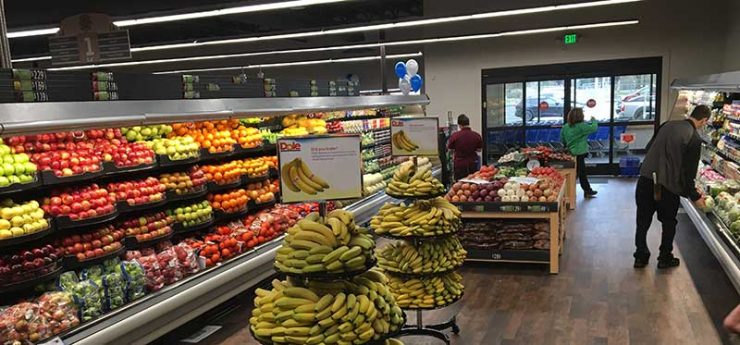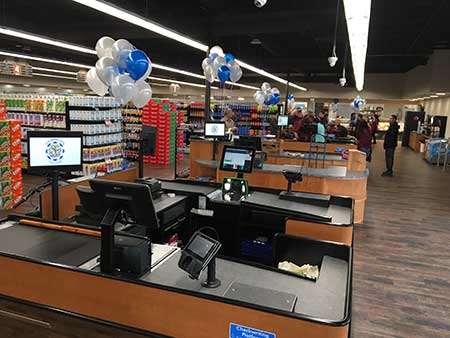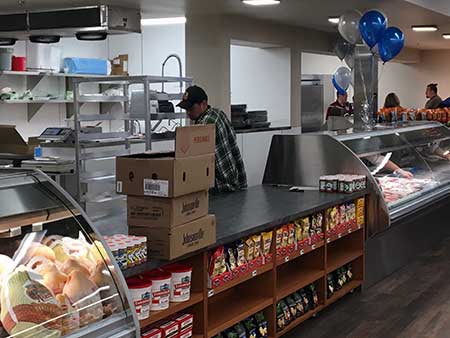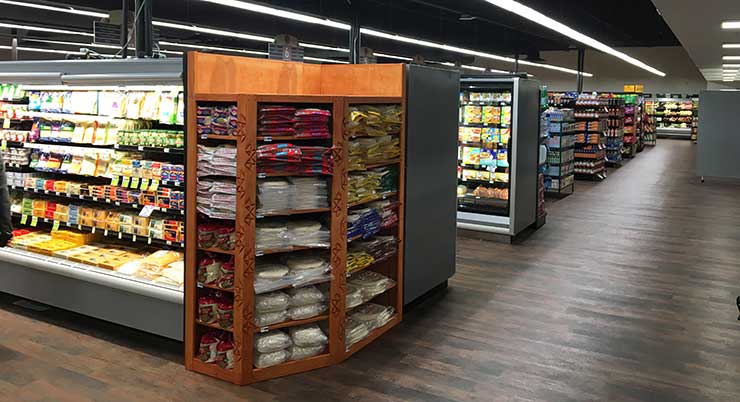
By Elizabeth Zach, RCAC staff writer
Hoopa Valley, Calif. – Hoopa Valley residents live near pastoral landscapes, rough rivers, and dense forests teeming with an abundance of fish and game. Yet, the abundance underscores the fact that healthy food scarcity exists in places we might not expect. In Hoopa Valley for instance, residents struggled to find wholesome food.
The distance between Hoopa and Willow Creek, which has a grocery store, is just 12 miles, but the roads are serpentine. Large full-scale grocery stores and big box retailers can be found farther north in Eureka, but that’s about 60 miles away.
“There’s a high degree of food insecurity here,” Vicki Estes-Bruff, diabetes program coordinator for K’ima:w Medical Center in the Hoopa Valley, recently observed.
Both Hoopa’s geographical isolation and its lack of comprehensive public transportation services contribute to the irony and misfortune that while healthy food should be easy to find, it generally isn’t.
Until recently, that is.

In March, the Hoopa Valley Tribe opened its own grocery store with a ribbon-cutting ceremony and grand reception. Tribal leaders and members had spent nearly three years painstakingly planning for the opening, which drew curious shoppers who strolled the aisles, learned about additional services Hoopa Shopping Center will offer, (such as cooking and Tai Chi classes), and attended shopping tours that focused on nutrition.
“Since the store is located within walking distance to several neighborhoods and businesses, it will help ease key transportation barriers,” said Georgianne Pillsbury, the RCAC loan officer who worked with the Tribe.
The project was made possible with a $4.2 million loan from the local Arcata Economic Development Corporation, with a $1.4 million participation loan from Rural Community Assistance Corporation (RCAC) and $1.4 million from Northern California Community Loan Fund. The Hoopa Tribe contributed a $1.5 million investment in the project.
The three CDFI mission-driven lenders collaborated to give Tribal members accessibility to basic grocery shopping with an emphasis on healthy foods. That accessibility has been lacking for three years since a previous, privately-owned store closed. Tribal ownership also provides the added benefit of control over product and management quality, which were also previous issues.
This partnership, says Ross Welch, Arcata Economic Development Corporation’s executive director, lays the groundwork for more potential opportunities.

“This is our largest project to date,” he says. “Either RCAC or NCCLF might have been able to do this loan by themselves, but there are benefits for all of us if we partnered on this project. And there are benefits for the Tribe with having a relationship with three CDFIs.” According to Hoopa Valley Tribal Chairman Ryan Jackson, the store has become critical to helping Tribal members, many of whom suffer from diabetes and other diseases related to poor nutrition. Not only is having more fresh produce available a significant achievement, so is the Tribe’s ownership, which allows members to determine what types of food can and should be sold. Pillsbury notes that local organic products will be featured prominently in the store, which also includes a deli, meat department and coffee kiosk.
“There really was a critical need on the Reservation because we have food security issues and poverty here,” Jackson says. The Tribe is working with local producers to attain organic certification from Humboldt County, and also with a local agriculture program so that locally grown fruit and vegetables can be sold at the store.
“We really are working hard to promote local sustainability, and to make sure that products are affordable,” he says.
The store’s entrance is an appealing structure with cedar plank scaffolding that resembles a picture frame, which was modeled on traditional Hoopa homes. It also provides sheltered outdoor seating, and photovoltaic solar panels on the roof help the store save on energy costs. The same understated design frames the store’s well-lit and well-kept interior, with mural graphics and décor that reflect the Hoopa’s history and culture.

“We held community meetings to ask residents what they would want the store to be like,” says Joe Davis, a grant writer and planner for the Hoopa Valley Tribe. “It took a long time to collect those ideas but we kept hearing that they wanted a clean store, with wide and open aisles. We think we achieved that.”
Plans for the two-story grocery store building got underway in June 2016. Before then, the Tribe had leased the property to Ray’s Food Place but the lease was not renewed.
While the Tribe might have approved a national supermarket chain store to replace Ray’s, the idea of a genuinely independent grocery store gradually drew wider interest and support. Residents in the rural community, including the Weitchpec, Pecwan and Orleans areas, mostly shopped at convenience stores, or traveled to Arcata or Eureka for groceries. The Hoopa Mini Mart Gas Station had begun shelving items such as frozen foods, toilet paper and canned goods. But clearly, a more sustainable solution would have to be found.
“These stores were doing their best to fill the gap, but they were really limited by space in terms of what they could actually stock,” Davis says.
In early 2017, the Tribe solicited building plans from more than 20 engineering firms; and three responded. By July 2017, the Tribe hired Greenway Partners, a Humboldt County engineering and planning firm to guide the community meetings.
They also hired local contractors who are Tribal members. Over six months, they tore down the old store’s framework, removed equipment such as condensers and refrigerators that no longer worked, and repaired pipes and electrical infrastructure that could still be salvaged. Meanwhile, there were unexpected challenges, including redesigning the parking lot and searching for a store operations manager.
They also started searching for financial support.
“We started developing lending sources,” says Davis, who wrote the store’s business plan. “We had a Bureau of Indian Affairs (BIA) guaranteed loan, and we started talking to nonprofits, including RCAC.”
Aside from the obvious benefit of offering residents more healthy food options, the Tribe also focused on job creation. The store initially advertised for nearly 50 positions for managers, a bookkeeper, cashiers, and produce and meat clerks. Today, about 20 of those positions are filled and hiring continues.
This, along with Davis’s estimates that the store serves close to 10,000 customers who live in Hoopa Valley, Willow Creek and in eastern Humboldt County’s unincorporated areas, reflect positive economic forecasts for the grocery store business. In working with the Tribe to prepare the RCAC loan, Pillsbury quoted a 2017 report that said “industry revenue is projected to grow to $624 billion over the five years to 2022. As consumers become more health conscious … they tend to purchase a greater variety of all-natural and organic products.”
Welch agrees with Pillsbury’s assessment, adding, “The loan was a big deal for us, and it was obviously a big deal for the Tribe, too.”
(Feature photo: The store’s fresh produce aisle, where the Tribe hopes to soon sell locally grown fruit and vegetables.)
*All photos taken by Georgianne Pillsbury.
